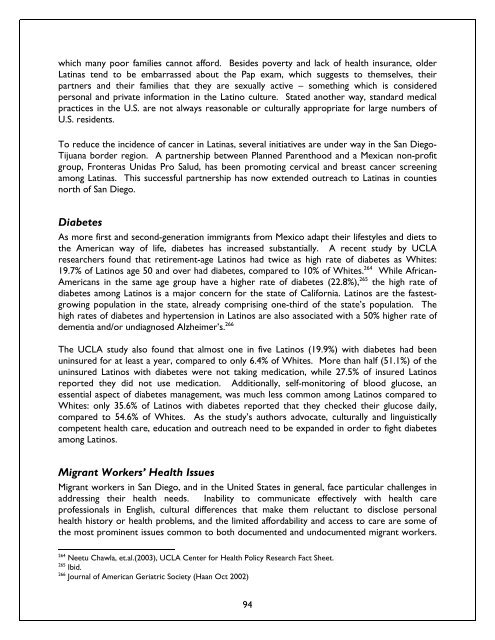Blurred Borders - International Community Foundation
Blurred Borders - International Community Foundation
Blurred Borders - International Community Foundation
Create successful ePaper yourself
Turn your PDF publications into a flip-book with our unique Google optimized e-Paper software.
which many poor families cannot afford. Besides poverty and lack of health insurance, older<br />
Latinas tend to be embarrassed about the Pap exam, which suggests to themselves, their<br />
partners and their families that they are sexually active – something which is considered<br />
personal and private information in the Latino culture. Stated another way, standard medical<br />
practices in the U.S. are not always reasonable or culturally appropriate for large numbers of<br />
U.S. residents.<br />
To reduce the incidence of cancer in Latinas, several initiatives are under way in the San Diego-<br />
Tijuana border region. A partnership between Planned Parenthood and a Mexican non-profit<br />
group, Fronteras Unidas Pro Salud, has been promoting cervical and breast cancer screening<br />
among Latinas. This successful partnership has now extended outreach to Latinas in counties<br />
north of San Diego.<br />
Diabetes<br />
As more first and second-generation immigrants from Mexico adapt their lifestyles and diets to<br />
the American way of life, diabetes has increased substantially. A recent study by UCLA<br />
researchers found that retirement-age Latinos had twice as high rate of diabetes as Whites:<br />
19.7% of Latinos age 50 and over had diabetes, compared to 10% of Whites. 264 While African-<br />
Americans in the same age group have a higher rate of diabetes (22.8%), 265 the high rate of<br />
diabetes among Latinos is a major concern for the state of California. Latinos are the fastestgrowing<br />
population in the state, already comprising one-third of the state’s population. The<br />
high rates of diabetes and hypertension in Latinos are also associated with a 50% higher rate of<br />
dementia and/or undiagnosed Alzheimer’s. 266<br />
The UCLA study also found that almost one in five Latinos (19.9%) with diabetes had been<br />
uninsured for at least a year, compared to only 6.4% of Whites. More than half (51.1%) of the<br />
uninsured Latinos with diabetes were not taking medication, while 27.5% of insured Latinos<br />
reported they did not use medication. Additionally, self-monitoring of blood glucose, an<br />
essential aspect of diabetes management, was much less common among Latinos compared to<br />
Whites: only 35.6% of Latinos with diabetes reported that they checked their glucose daily,<br />
compared to 54.6% of Whites. As the study’s authors advocate, culturally and linguistically<br />
competent health care, education and outreach need to be expanded in order to fight diabetes<br />
among Latinos.<br />
Migrant Workers’ Health Issues<br />
Migrant workers in San Diego, and in the United States in general, face particular challenges in<br />
addressing their health needs. Inability to communicate effectively with health care<br />
professionals in English, cultural differences that make them reluctant to disclose personal<br />
health history or health problems, and the limited affordability and access to care are some of<br />
the most prominent issues common to both documented and undocumented migrant workers.<br />
264<br />
Neetu Chawla, et.al.(2003), UCLA Center for Health Policy Research Fact Sheet.<br />
265<br />
Ibid.<br />
266<br />
Journal of American Geriatric Society (Haan Oct 2002)<br />
94















